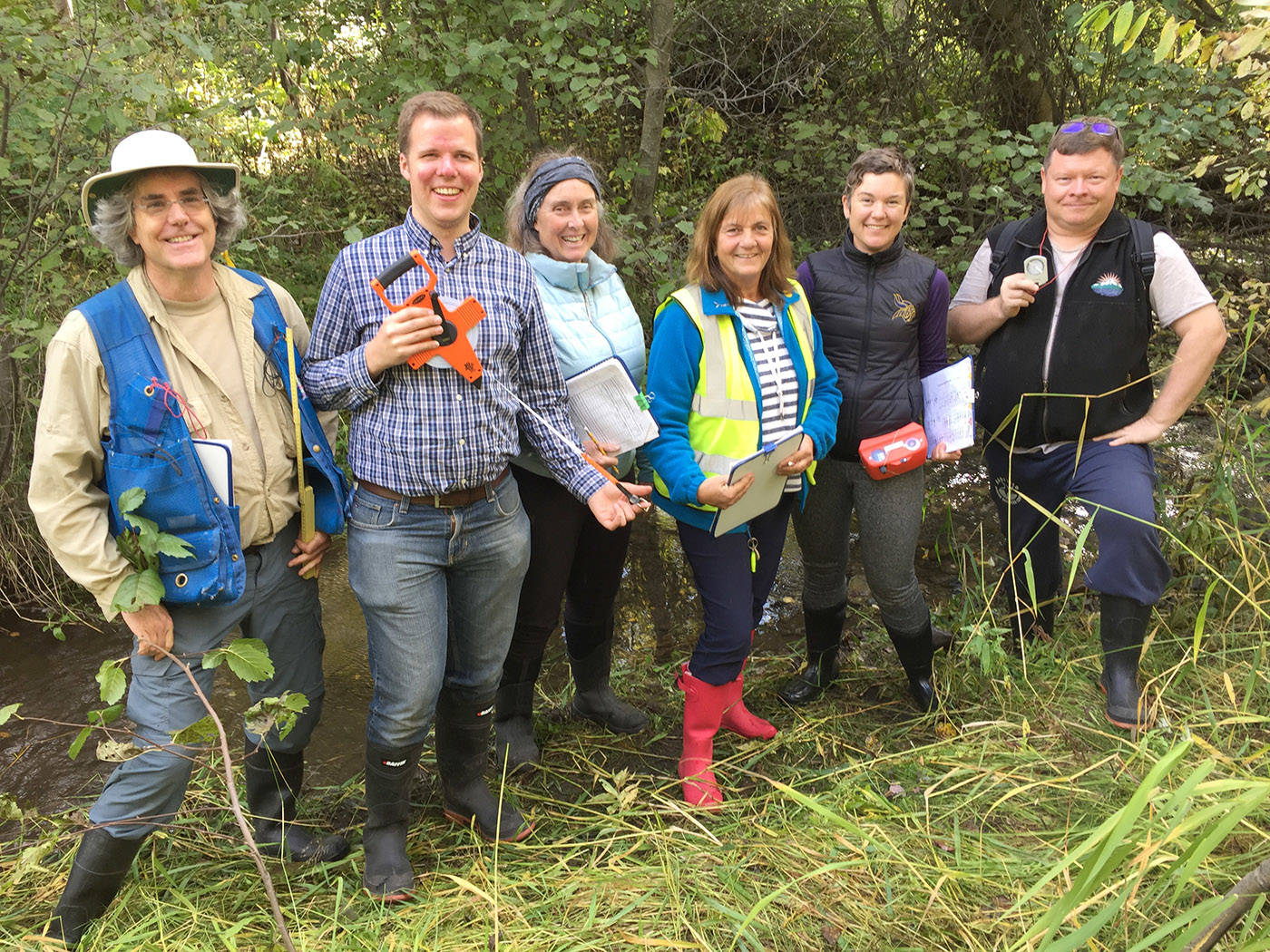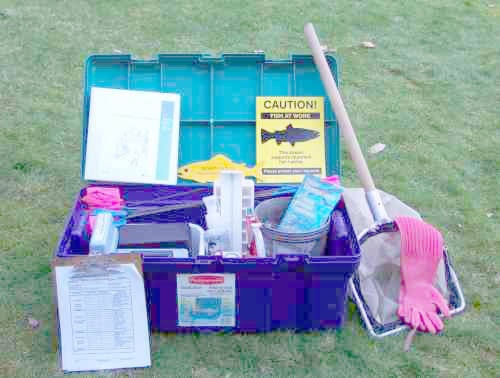About three weeks ago, just before Fall set in, a handful of teachers from Nechako Valley Secondary School were out in the field on the banks of Murray Creek learning how to use Streamkeeper kits. They were preparing for an exciting new initiative coming soon to SD#91 which will have students using a variety of measuring tools to monitor impacts of restoration efforts in small streams and tributaries of the Nechako River.
Stewardship vision
Restoration of streams is by no means a new thing. Local work in this area started in earnest by volunteers over 10 years ago by the Vanderhoof Fish & Game Club. Many may be aware of the great results a progeny of theirs, the Nechako Environmental & Water Stewardship Society (NEWSS), has achieved with the volunteer-run Murray Creek Rehabilitation Project – a gold standard model of stream restoration – to name just one of their projects.
Student advocates
On the whole, widespread awareness of the importance of stream restoration is still emerging. Stream damage is something the youth of today have inherited due to previous generations’ lack of knowledge about the negative impact of land clearing right up to creek banks for farming, forestry and ranching. The streamkeeper monitoring will make stewardship advocates of students moving through the new curriculum.
Monitoring data
Although we know that diligent stream restoration work has vastly improved the vitality of Murray Creek and the adjacent riparian zone, this has only been done by observation. There is no current process in place to scientifically measure results of investing in the costs associated with work itself. Olin Albertson, Environmental Biologist at Avison Management Services, explains that there is little funding for monitoring the impact that restoration is having on stream health, the impact of the work that NEWSS has done.
“Funding for monitoring is short, that’s part of what the kids are going to be doing,” he says. “We can anecdotally definitely see that it is working, but we are not yet quantitatively able to measure the impact.”
New curriculum
“Teachers are really keen to get the students out of the classroom and into the field where they can start understanding what they are looking at by experiencing it, not just learning the theory and doing the measurements in a classroom,” says Casey Litton NVSS Science Department.
“It’s all coming together at the right time with the new curriculum incorporating more experiential learning while applying real life science… this will be a huge success story,” he says.
Integrated disciplines
“This Streamkeepers project is an example where we can blend subjects like ecology, photography and programming or graphics to support one another. For example, the photography student is taking the photo, the programming student creates the 3-D functional model and the ecology student is doing the write up and they all work on a collaborative presentation. Partnering students up together across different disciplines is the direction we have in education now because everything we do in life is a collaboration, and in education we must as close as possible mimic real life.”
Watershed research
With the Streamkeeper project, students will be citizen scientists, learning understanding, monitoring and mentoring younger grades while gathering real-world data to help further UNBC research monitoring water quality, fish populations, wildlife habitat and conditions for salmon spawning.
Students will get to witness first-hand the quantitative effect of positive steps taken to combat erosion, limit cattle access, repair road culverts, deepen and oxygenate water channels and many other activities involved in restoring streams and fish habitat to their healthy ‘pre-human contact’ state.
Streamkeeper kits
The Streamkeeper kits, purchased with funding from Centerra Gold Mount Milligan, makes it easy to take accurate measurements. The kits contain invertebrate samplers, water quality test kits and various surveying supplies.
Multi-partnership
This ‘Streamkeepers’ initiative brings together land owners, businesses, schools, scientists and environmental stewards in a way that will collaborate to promote awareness and education about stream health and fish habitat protection. It will further the work already being done by NEWSS and support rehabilitation of several other damaged creeks in the watershed.
“When people talk about citizen-based science, there’s a whole bunch of reasons why you do that,” says Barry Booth, Research Associate at UNBC. “It doesn’t only need to be delivering data to decision-makers to influence policy, it can be as simple as community engagement – which is potentially as important as collecting data to help shift policy. With community engagement you start getting advocacy happening, you start getting landowners involved, you start building new partnerships.”
Real-world science
“The feedback is it’s nice to come in and learn the ecology of a healthy stream, but what is really interesting is to say ‘Let’s go to a degraded stream, do the pre-restoration analysis, monitor and observe the rehabilitation taking place and do the post-restoration measurements,’” says Litton.
He says kids don’t want to collect data for the sake of collecting data. What they’ll be able to do now is gather data which actually shows very practically how the streams have changed as a result of the restoration.
“Although we can functionally do the testing in the classroom it’s not a real world context where they are making that connection. Nothing matches problem-solving skills learned in a real-world application.”
SD#91 stepping up
The school district is creating an opportunity for students to get involved with this real-world science application, while adding value to ongoing university research. “SD#91 have been hugely progressive and I think that they need to be congratulated because of their openness and interest in partnering” says Wayne Salewski, Chair Nechako Environment Water Stewardship Society (NEWSS). “These are not just teachers or administrators doing their job, it is individuals putting time into something they are passionate about.”
Collaboration
ZoAnn Morten, Executive Director at Pacific Streamkeepers Federation travelled up from Vancouver to train the teachers on how to use the Streamkeeper kits. She had this to say:
“The excitement and collaboration in this town is huge. This is a smaller community, but the teachers have come forward with a willingness to step outside of nine-to-five which has been lost in some areas of the province. My heart is huge! It’s been an absolute joy to be up here.”
UNBC research
The data gathered by the students will go into a Nechako Roundtable data portal receptacle, a living document showing progression over time. This will feed into work being done by the Integrated Watershed Research group of four UNBC professors investigating three research themes in the Nechako watershed:
1. Climate change and water - how climate change affects in particular run-off.
2. Sediment transport - sources of sediment which impact spawning beds, e.g. dam construction and other significant landuse changes.
3. Watershed governance and tools - to make better decisions, web-based portal or search engine with data on the Nechako Watershed.
“This project, from a university perspective, is quite surprising the way it’s evolved because we never started out with this in mind. It’s become so much more!” says Booth.

